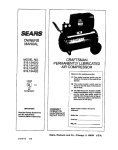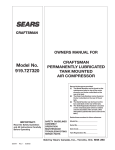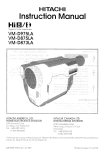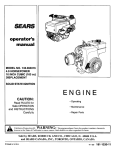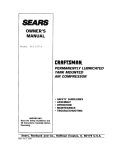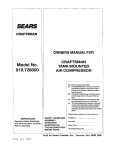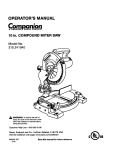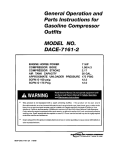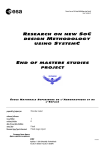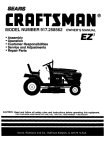Download Craftsman 919.727320 Troubleshooting guide
Transcript
8E / S
CRAFTSMAN
OWNERS
MANUAL FOR
CRAFTSMAN
PERMANENTLY
LUBRICATED
TANK MOUNTED
AIR COMPRESSOR
Model No.
919.727320
Record in the spaces provided.
(1) The Model Number can be found on the
maintenance label on top of the motor
shroud or on the bar code label on the
rear of air tank(2)
The Date Code Number can be found on
the bar cede label on the rear of the air
tank.
(3)
The Serial Number can be found on the
bar code labe( on the rear of the tank.
(4)
The Tank Registration Number is located
on the metal data plate which is welded
onto the backside of the air tank- (This
data plate is painted the same color as the
tank-)
Retain these numbers for future reference,
IMPORTANT:
Read the Safety Guidelines
and All Instructions Carefully
Before Operating
SAFETY GUIDELINES
ASSEMBLY
OPERATION
MAINTENANCE
TROUBLESHOOTING
REPAIR PARTS
Model
Serial
No
No
Date Code.
Tank Registration
No
?
'.t
Sold
D20417
Rev. 1
6/28/00
by Sears
Canada,
Inc.,
Toronto,
Ont.
M5B
2B8
WARRANTY .........................................................
2
SAFETY GUIDELINES ......................................... 2
WARNING CHART ............................................ 3-5
GENERAL INFORMATION ................................... 6
GLOSSARY ..........................................................
6
SPECIFICATION CHART ..................................... 7
DESCRIPTION OF OPERATION .......................... 7
TOOLS NEEDED FOR ASSEMBLY ...................... 7
ASSEMBLY ..........................................................
8
BREAK-IN PROCEDURES ................................... 8
Location of AirCompressor ............................ 8
Lubrication and Oil ......................................... 8
Grounding Instructions.................................... 8
Voltage and Circuit Protection ......................... 9
Break-in Procedure ......................................... 9
OPERATING PROCEDURES ....................................... 9
MAINTENANCE ...........................................................
10
Air Filter - Inspection and Replacement .................. 10
Check Valve-Replacement .................................... 10
Safety Valve - Inspection ........................................ 10
Motor ......................................................................
10
Storage....................................................... _........... 10
TROUBLESHOOTING GUIDE ................................ 11-12
AIR COMPRESSOR DIAGRAM ................................... 14
PARTS LIST .................................................................
15
COMPRESSOR PUMP DIAGRAM .............................. 16
PARTS LIST .................................................................
17
SERVICE NOTES ..........................................................
18
HOWTO ORDER REPAIR PARTS ................ Back Cover
FULL ONE YEAR WARRANTY
ON AIR COMPRESSORS
If this air compressor fails due to a defect in material or workmanship within one year from the date
of purchase, RETURN IT TO THE NEAREST SEARS SERVICE CENTER THROUGHOUT CANADA AND
SEARS WILL REPAIR IT, FREE OF CHARGE.
If this air compressor is used for commercial
days (90) from the date of purchase.
or rental purposes,
the warranty will apply for ninety
This Craftsman Air Compressor warranty gives you specific legal rights and you may have other
rights which vary from province to province.
Sears
Canada,
Inc., Toronto,
Ont. M5B 2B8
This manual contains information that is important for you to know and understand. This information reTatesto protecting
YOUR SAFETY and PREVENTING EQUIPMENT PROBLEMS. To help you recognize this information, we use the symbols
to the right. Please read the manual and pay attention to these sections.
DANGER indicates an imminently hazardous situation which, if
not avoided, will result in death or serious iniurv,
CAUTION indicates a potentially hazardous situation which, if
not avoided, may result in minor or moderate iniurv.
WARNING indicates a potentially hazardous situation which, it
not avoided, could result in death of serious Iniurv.
CAUTION used without the safety alert symbol indicates a
potentially hazardous situation which, if not avoided, may result
in Drooertv damaae.
2 -- ENG
D20417
Rev. I
6/28/00
SAVE THESE INSTRUCTIONS
IMPROPER
OPERATION OR MAINTENANCE
OF THIS PRODUCT COULD RESULT IN SERIOUS
DAMAGE. READ AND UNDERSTAND ALL WARNINGS AND OPERATING INSTRUCTIONS BEFORE
INJURY AND PROPERTY
USING THIS EQUIPMENT.
SKOEXPOSOO
1
WHAT
CAN HAPPEN
HOW TO PREVENT IT
IT Is NORMAL FOR ELECTRICAL CONTACTS WITHIN THE
MOTOR AND PRESSURESWITCH TO SPARK.
ALWAYS OPERATE THE COMPRESSOR
LATED AREA FREE OF COMBUSTIBLE
GASOLINE OR SOLWENT VAPORS.
IF ELECTRICAL SPARKS FROM COMPRESSOR COME INTO
CONTACT WITH FLAMMABLE VAPORS, THEY MAY IGNITE,
CAUSING FIRE OR EXPLOSION.
IF SPRAYING FLAMMABLE MATERIALS, LOCATE COMPRESSOR AT LEAST 20 FEET AWAY FROM SPRAY AREA. AN
ADDITIONAL LENGTH OF HOSE MAY BE REQUIRED.
STORE FLAMMABLE MATERIALS
AWAY FROM COMPRESSOR.
RESTRICTING ANY OF THE COMPRESSOR VENTILATION
OPENINGS WILL CAUSE SERIOUS OVERHEATING AND
COULD CAUSE FIRE.
IN A WELL VENTIMATERIALS,
IN A SECURE
LOCATION
NEVER PLACE OBJECTS AGAINST OR ON TOP OF COMPRESSOR. OPERATE COMPRESSOR IN AN OPEN AREA AT
LEAST 12 INCHES AWAY FROM ANY WALL OR OBSTRUCTION THAT WOULD RESTRICT THE FLOW OF FRESH AIR TO
THE VENTILATION OPENINGS.
OPERATE COMPRESSOR IN A CLEAN DRY, WELL VENTILATED AREA. DO NOT OPERATE UNiT INDOORS OR IN ANY
CONFINED AREA.
UNATrENDED OPERATION OF THIS PRODUCT COULD
RESULT IN PERSONAL INJURY OR PROPERTY DAMAGE.
ALWAYS REMAIN IN ATTENDANCE
WHEN IT IS OPERATING.
WITH THE PRODUCT
.s,o oo.s
1 .o
AIR TANK:
THE FOLLOWING
CONDITIONS
VIOLENT TANK EXPLOSIOI_AND
COULD LEAD TO A WEAKENING OF THE TANK, AND RESULT IN A
COULD CAUSE PROPERTY
DAMAGE OR SERIOUS INJURY.
WHAT CAN HAPPEN
HOW TO PREVENT IT
1. FAILURE TO PROPERLY DRAIN CONDENSED WATER
FROM THE TANK, CAUSING RUST AND THINNING OF THE
STEEL TANK.
DRAIN TANK DAILY OR AFTER EACH USE. IF TANK DEVELOPS A LEAK, REPLACE IT IMMEDIATELY WITH A NEW TANK OR
REPLACE THE ENTIRE COMPRESSOR.
2. MODIFICATIONS
NEVER DRILL INTO, WELD, OR MAKE ANY MODIFICATIONS
TO THE TANK OR ITS ATTACHMENTS.
OR ATTEMPTED REPAIRS TO THE TANK.
3. UNAUTHORIZED MODIFICATIONS TO THE UNLOADER
VALVE SAFETY VALVE, OR ANY OTHER COMPONENTS
WHIC_ CONTROL TANK PRESSURE.
THE TANKIS DESIGNED TO WITHSTAND SPECIFIC OPERATING
PRESSURES. NEVER MAKE ADJUSTMENTS
OR PARTS
SUBSTITUTIONS TO ALTERTHE
FACTORY SET OPERATING
PRESSURES.
4. EXCESSIVE VIBRATION CAN WEAKEN THE AIR TANK
AND CAUSE RUPTURE OR EXPLOSION.
ATTACHMENTS
& ACCESSORIES:
EXCEEDING THE PRESSURE RATING OF AIR TOOLS, SPRAY
GUNS, AIR OPERATED ACCESSORIES, TIRES AND OTHER
INFLATABLES CAN CAUSE THEM TO EXPLODE OR FLY
APART, AND COULD RESULT IN SERIOUS INJURY.
'
t
FOR ESSENTIAL CONTROL OF AIR PRESSURE, YOU MUST
INSTALL A PRESSURE REGULATOR AND PRESSURE GAUGE
TO THE AIR OUTLET OF YOUR COMPRESSOR. FOLLOW THE
EQUIPMENT MANUFACTURERS RECOMMENDATION
AND
NEVER EXCEED THE MAXIMUM ALLOWABLE PRESSUre
RATING OF ATrACHMENTS. NEVER USE COMPRESSOR l J
INFLATE SMALL LOW-PRESSURE OBJECTS SUCH AS
CHILDREN'S TOYS, FOOTBALLS, BASKETBALLS. ETC.
3 -- ENG
D20417
Rev.1
6/28/00
RISK FROM FLYING
OBJECTS
WHAT CAN HAPPEN
HOWTO PREVENT IT
THE COMPRESSED AIR STREAM CAN CAUSE SOFT TISSUE
DAMAGE TO EXPOSED SKIN AND CAN PROPEL DIRT, CHIPS,
LOOSE PARTICLES AND SMALL OBJECTS AT HIGH SPEED,
RESULTING IN PROPERTY DAMAGE OR PERSONAL INJURY.
ALWAYS WEAR ANSI Z87.1 APPROVED SAFETY GLASSES
WITH SIDE SHIELDS WHEN USING THE COMPRESSOR.
NEVER POINT ANY NOZZLE OR SPRAYER TOWARD ANY
PART OF THE BODY OR AT OTHER PEOPLE OR ANIMALS.
ALWAYS TURN THE COMPRESSOR OFF AND BLEED PRESSURE FROM THE AIR HOSE AND TANK BEFORE ATTEMPTING
MAINTENANCE, ATI'ACHING TOOLS OR ACCESSORIES.
RISK TO BREATHING
WHAT CAN HAPPEN
HOW TO PREVENT IT
THE COMPRESSED AIR FROM YOUR COMPRESSOR IS NOT
SAFE FOR BREATHING!
THE AIR STREAM MAY CONTAIN
CARSON MONOXIDE, TOXIC VAPORS OR SOUD PARTICLES
FROM THE TANK.
ALWAYS OPERATE AIR COMPRESSOR OUTSIDE IN A CLEAN,
WELL VENTILATED AREA. AVOID ENCLOSED AREAS SUCH AS
GARAGES, BASEMENTS, STORAGE SHEDS, WHICH LACK A
STEADY EXCHANGE OF AIR. KEEP CHILDREN, PETS AND
OTHERS AWAY FROM AREA OF OPERATION.
NEVER INHALE AIR FROM THE COMPRESSOR EITHER
DIRECTLY OR FROM A BREATHING DEVICE CONNECTED TO
THE COMPRESSOR.
SPRAYED MATERIALS SUCH AS PAINT, PAINT SOLVENTS,
PAINT REMOVER, INSECTICIDES, WEED KILLERS, CONTAIN
HARMFUL VAPORS AND POISONS.
WORK IN AN AREA WITH GOOD CROSS-VENTILATION.
READ
AND FOLLOW THE SAFETY INSTRUCTIONS
PROVIDED ON
THE LABEL OR SAFETY DATA SHEETS FOR THE MATERIAL
YOU ARE SPRAYING. USE A NIOSWMSHA APPROVED
RESPIRATOR DESIGNED FOR USE WITH YOUR SPECIFIC
APPLICATION.
RISK OF ELECTRICAL
SHOCK
WHAT CAN HAPPEN
HOW TO PREVENT IT
YOUR AIR COMPRESSOR IS POWERED BY ELECTRICITY.
LIKE ANY OTHER ELECTRICALLY POWERED DEVICE, IF IT IS
NOT USED PROPERLY IT MAY CAUSE ELECTRIC SHOCK,
NEVER OPERATE THE COMPRESSOR
RAINING OR IN WET CONDITIONS.
REPAIRS ATTEMPTED BY UNQUALIFIED PERSONNEL CAN
RESULT IN SERIOUS INJURY OR DEATH BY ELECTROCUTION.
ANY ELECTRICAL WIRING OR REPAIRS REQUIRED ON THIS
PRODUCT SHOULD BE PERFORMED BY AUTHORIZED
SERVICE CENTER PERSONNEL IN ACCORDANCE WITH
NATIONAL AND LOCAL ELECTRICAL CODES,
NEVER OPERATE COMPRESSOR
REMOVED OR DAMAGED.
ELECTRICAL GROUNDING:
FAILURE TO PROVIDE ADEQUATE
GROUNDING TO THIS PRODUCT COULD RESULT IN SERIOUS
INJURY OR DEATH FROM ELECTROCUTION.
SEE GROUNDiNG IN_;TRVCTIQNS.
R_. 1
6/28/00
WITH COVER COMPONENTS
MAKE CERTAINTHAT THE ELECTRICAL CIRCUIT TO WHICH
THE COMPRESSOR IS CONNECTED PROVIDES PROPER
ELECTRICAL GROUNDING, CORRECT VOLTAGE AND
ADEQUATE FUSE PROTECTION.
4 -- ENG
D2_17
OUTDOORS WHEN IT IS
You
- of a
and
and
have purchased an air compressor unit consisting
one cylinder, single-stage air compressor pump
air tank. Included are wheels, regulator, gauges,
handle.
An inline air filter which removes moisture and dirt from
compressed air should be used where applicable.
An inline regulator can be used if a more precise
adjustment of air pressure is needed downstream.
This air compressor requires no oil. Now you can enjoy
all the benefits of having an air compressor without
ever having to purchase, add or change oil.
Your air compressor can be used for operating paint
spray guns, air tools, blow guns, nailers/staplers,
air
brushes, and inflator kits. An air pressure regulator is
required for most of the applications.
CFM:
Cubic Feet per Minute.
SCFM: Standard Cubic Feet per Minute; a unit of measure of air delivery.
PSh Pounds per Square Inch; a unit of measure of pressure.
Cut-Out Pressure: When you turn on your air compressor and it begins to run, air pressure in the air tank begins to build. It builds to a certain high pressure before
the motor automatically shuts off - protecting your air tank
from pressure higher than its capacity. The high pressure at which the motor shuts off is called "cut-out pressure."
ASME: American Society of Mechanical Engineers; made,
tested, inspected and registered to meet the standards
of the ASME.
Cut-In Pressure: While the motor is off, air tank pressure drops as you continue to use your accessory. When
the tank pressure drops to a certain low level and the
pressure switch lever is in "Auto", the motor will restart
automatically. The low pressureat whichthe motor automatically restarts is called "cut-in pressure."
CSA: Electrical products sold in Canada are required to
be certified to the applicable CSA standard (s). Canadian
Standards Association (CSA) is a standards writing and
safety testing organization. Products that are CSA certified have been evaluated and tested and found to meet
or exceed the applicable CSA standard (s) for safety and
electrical performance.
Model No.
919.727320
Bore
2 3/8"
Stroke
1.35"
Voltage- Single Phase
120
Minimum Branch Circuit Requirement
15 amps
Fuse Type
Time Delay
Amperage at Maximum Pressure
15.0
Air TanWCapacity
ASME/25 gal. (U.S.)
Approximate Cut-in Pressure
100
Approximate Cut-out Pressure
130
SCFM @40 psi
7.8
SCFM @90 psi
5.5
6 -- ENG
D20417
Rev. 1
6/28/00
Air CompressorPump: Tocompress
air, the piston
moves up and down in the cylinder. On the downstroke,
air is drawn in through the air intake valves. The exhaust
valves remain closed. On the upstroke of the piston, air
is compressed. The intake valves close and compressed
air is forced out through the exhaust valves, through the
outlet tube, through the check valve and into the air tank.
Check Valve: When the air compressor is operating, the
check valve is "open", allowing compressed air to enter
the air tank. When the air compressor reaches "cut-out"
pressure, the check valve "closes", allowing air pressure to remain inside the air tank.
Pressure Switch: The pressure switch is fitted with a
small lever. It is labeled "Auto/O" for automatic run or
off. In the "O" position, the motor will not run. In the "Auto"
position, it automatically starts the motor when the air
tank pressure drops below the factory set "cut-in" pressure. It stops the motor when the air tank pressure reaches
the factory set "cut-out" pressure.
Pressure Release Valve: The pressure release valve located on the side of the pressure switch is designed to
automatically release compressed air trapped within the
compressor head and outlet tube. This short release of
air will occur when the air compressor reaches "cut-out"
pressure or the unit is shut off. If the air is not released,
the motor will not be able to start when next required.
Flow Valve: The flow
head as the motor is
motor reaches normal
closes and the pump
quiring less amp draw
valve allows air to flow from the
getting "up to speed". Once the
operating speed, the flow valve
begins to compress air, thus reon initial start.
Regulator: The air pressure coming from the air tank is
controlled by the regulator. The regulator control knob is
a vibration proof design. Lift the regulator knob to engage and depress the knob to lock. Turn the regulator
knob clockwise to increase pressure and counter-clockwise to decrease pressure. To avoid minor readjustment
after making a change in pressure setting, always approach the desired pressure from a lower pressure. When
reducing from a higher to a lower setting, first reduce to
some pressure less than that desired, then bring up to
the desired pressure. Depending on the air requirements
of each particular accessory, the outlet regulated air pressure may have to be adjusted while operating the accessory.
Regulator Gauge: The outlet pressure gauge indicates
the air pressure available at the outlet side of the regulator. This pressure is controlled by the regulator and is
always less than or equal to the tank pressure. See "Operating Procedures".
Tank Pressure Gauge: The tank pressure
cates the reserve air pressure in the tank.
gauge indi-
Cooling System: This compressor contains an advanced
design cooling system. At the heart of this cooling system is an engineered fan. It is perfectly normal for this
fan to blow air through the vent holes in large amounts.
You know that the cooling system is working when air is
being expelled.
Drain Valve: This valve is located at the bottom of the
tank. To drain accumulated moisture from the tank, pull
on the safety valve until tank pressure is 15 PSI. Unscrew the drain valve and allow the water to drain.
Safety Valve: If the pressure switch does not shut off the
air compressor at its cut-out pressure setting, the safety
--valve will protect the tank against high pressure by "popping out" at its factory set pressure (slightly higher than
the pressure switch cut-out setting).
• a 9116" socket and an open end wrench for attaching
the wheels
• a 3/8" open end wrench or socket to tighten handle
screws
7 -- ENG
D20417
Rev. 1
6/28/00
Installing Wheels, Handles, Rubber Foot
Strip
THE WHEELS AND HANDLE DO NOT PROVIDE
ADEQUATE CLEARANCE, STABILITY OR SUPPORT FOR PULLING THE UNIT UP AND DOWN
STAIRS OR STEPS. THE UNIT MUST
BELIFTED, OR PUSHED UPARAMP.
Location of the Air Compressor
Locate the air compressor in a clean, dry and well ventilated area. The air filter must be kept clear of obstructions which could reduce air delivery of the air compressor. The air compressor
should be located at least 12"
away from the wall or other obstructions that will interfere
with the flow of fresh intake and cooling air.
Lubrication
and Oil
This unit needs no lubrication
1.
Attach the handle to the compressor saddle by
inserting the handle inside the compressor saddle
and lining up the two bolt holes on each side. Install
the four screws, two on each side. Tighten securely.
2.
Install one shoulder bolt and one nut for each wheel.
Tighten securely. The compressor will sit level if the
wheels are properly installed.
3.
Clean and dry underside of air tank leg opposite
wheels. Remove the protective paper strip from the
adhesive backed rubber foot strip. Attach the rubber
foot strip to the bottom of leg. Press firmly into place.
If repairing or replacing cord or plug, the grounding wire
must be kept separate from the current-carrying
wires.
Never connect the grounding wire to a flat blade plug
terminal. The grounding wire has insulation with an outer
surface that is green with or without yellow stripes.
If these grounding instructions are not completely understood, or if in doubt as to whether the compressor is
properly grounded, have the installation checked by a
qualified electrician.
or oiling.
120 Veer Models
Grounding Instructions
240 Volt Models
wtmm
I_11_[_
RISK OF ELECTRICAL SHOCK. In the event of a
short circuit, grounding reduces the risk of shock
by providing an escape wire for the electric
current. This air compressor must be properly
grounded.
1S AMP PLUG
This portable air compressor is equipped with a cord having a grounding wire with an appropriate grounding plug.
The plug must be used with an outlet that has been installed and grounded in accordance with all local codes
and ordinances. The outlet must have the same configuration as the plug. DO NOT USE AN ADAPTER.
Inspect the plug and cord before each use. Do not use if
there are signs of damage.
IMPROPER GROUNDING
ELECTRICAL SHOCK.
CAN RESULT IN
Do not modify the plug that has been provided. If it
does not fit the available outlet, the correct outlet
should be installed
by a qualified
OUTLET
20 AMP PLUG
GROUNDED
GROUNO_3J
FIN
_
( _
I
Voltage and Circuit Protection
Refer to page 5 (Specification Chart) for the voltage and
circuit protection requirements of your compressor. Use
only a fuse or circuit breaker that is the same rating as
the branch circuit the air compressor
is operated on. If
the compressor
is connected to a circuit protected by
fuses, use only dual element time delay fuses.
Refer to Parts List Manual for your compressor. Certain
air compressor models can be operated on a 15 amp
circuit if:
technician.
8 -- ENG
Rev. 1
6/28/00
_
PiN
1. Voltage supply to circuit is normal.
D20417
OUTLET
2. Circuitisnot
(lights,
Break-in Procedure
used to supply any other electrical needs
appliances, etc.)
3. Extension cords comply with a 15 amp circuit breaker
or 15 amp time delay fuse.
4. Circuit is equipped with a 15 amp circuit
15 amp time delay fuse.
Serious damage may result if the following
break-in instructions are not closely followed.
breaker or
This procedure is required only once, before the air compressor is put into service.
If any of the above conditions cannot be met, or if operation of the compressor repeatedly causes interruption of
power, it may be necessary to operate it from a 20 amp
circuit. It is not necessary to change the cord set.
Extension
1. Set the pressure switch "AUTO/O" lever in the
"O" position for "Off".
2. Plug the power cord into the correct branch circuit
receptacle.
3. Do not attach hose to outlet. Leave the outlet open
to the atmosphere.
4. Turn the regulator clockwise,
opening it fully, to
prevent air pressure build-up in the tank.
5. Move the "AUTO/O" lever to "AUTO". The compressor will start.
6. RUN THE COMPRESSOR
FOR 15 MINUTES.
Make sure the regulator is open and there is no tank
pressure build-up.
7. After 15 minutes, close the regulator by turning it
counterclockwise.
The air tank will fill to cut-out
pressure and then the motor will stop.
Cords
It is preferable to use extra air hose instead of an extension cord to avoid voltage drop and power loss to the
motor, and to prevent overheating.
If an extension cord must be used, be sure it is:
• 12 gauge (AWG) or heavier. (Wire size increases as
gauge number decreases.
10 AWG and 8 AWG
may also be used. DO NOT USE 14 OR 16 AWG.)
• a three-wire extension cord that has a three-connec
tor grounding plug, and a three-slot receptacle that
will accept the plug.
• no longer than 50 feet
• in good condition
1.
2
Before attaching air hose or accessories, make
sure the "AUTO/O" lever is set to "O" and the air
regulator is closed.
6.
AKach hose and accessories.
Always operate the air compressor in wellventilated areas; free of gasoline or other solvent
vapors. Do not operate the compressor near the
spray area.
WHEN YOU ARE FINISHED:
7. Set the "AUTO/O" lever to "O".
TOO MUCH AIR PRESSURE CREATES A
HAZARDOUS RISK OF BURSTING. CARE-FULLY
FOLLOW STEPS 3 AND 5 BELOW EACH TIME
THE COMPRESSOR IS USED.
-
I!'_JLIJBL{e]_l
Compressed air from the outfit may contain water
condensation. Do not spray unfiltered air at an
item that could be damaged. Some air operated
tools or devices may require filtered air. Read the
instructions for the air tool or device.
8.
Turn the regulator counterclockwise
outlet pressure to zero.
9.
Remove the air tool or accessory.
and set the
10. Open-the regulator and allow the air to slowly
bleed from the tank. Close the regulator when
tank pressure is approximately 20 psi.
11. Drain water from air tank.
WATER WILL CONDENSE IN THE AIR TANK. IF
NOT DRAINED, WATER WILL CORRODE AND
WEAKEN THE AIR TANK CAUSING A RISK OF
AIR TANK RUPTURE.
3. Check the manufacturer's maximum pressure rating
for air tools and accessories. The regulator outlet
pressure must never exceed the maximum
pressure rating.
NOTE:
4. Turn the "AUTO/O" lever to "AUTO" and allow tank
pressure to build. Motor will stop when tank
pressure reaches "cut-out" pressure.
If drain cock valve is plugged, release all air
pressure. The valve can then be removed,
cleaned, then reinstalled.
5. Open the regulator by turning it clockwise. Adjust
the reg_dator to the correct pressure setting. Your
compressor is ready for use.
-*
12. After the water has been drained, close the drai,
valve. The air compressor can now be stored.
9 -- ENG
D20417
Rev.1
6/28/00
ri_kV/_,1:1
_il _[ct
UNIT CYCLES AUTOMATICALLY WHEN POWER IS ON. WHEN DOING MAINTENANCE, YOU MAY BE EXPOSED TO
VOLTAGE SOURCES, COMPRESSED AIR OR MOVING PARTS. PERSONAL INJURIES CAN OCCUR. BEFORE
PERFORMING ANY MAINTENANCE OR REPAIR, UNPLUG THE COMPRESSOR AND BLEED OFF ALL AIR PRESSURE.
ALL MAINTENANCE
AND REPAIR OPERATIONS
Air Filter - Inspection
NOT LISTED
and Replacement
MUST BE
Safety Valve - Inspection
Hotsurfacee. Riskof burn. Compressor heads
are exposed when filter cover is removed. Allow
compressor to cool prior to servicing.
Filter _--Filter
DONE BY A QUALIFIED SERVICE TECHNICIAN.
If the safety valve does not work properly,
over-pressurization may occur, causing air tank
rupture or an explosion. Before starting compressor, pull the Hng on the safety valve to make sure
that the safety valve operates freely. If the valve is
stuck or does not operate smoothly, it must be
replaced with the same type of valve.
Retainer
Motor
Keep the air filter clean at a[I times. Do not operate the compressor with the air filter removed.
A dirty air filter will not allow the compressor to operate at full
capacity. Before you use the compressor, check the air filter to
be sure it is clean.
Check Valve Cleaning - Replacement
The motor has an automatic reset thermal overload protector.If
the motor overheats for any reason, the overload protector will
shut off the motor. The motor must be allowed to cool down
before restarting. The compressor will automatically restart
after the motor cools.
tf the overload protector shuts the motor off frequently, check
for a possible voltage problem. Low voltage can also be suspected when:
1. The motor does not get up to full power or speed.
Risk of personal injury. Manifold assembly contains compressed air which can be haz=_rdous.
Manifold gets hot during operation.
Before servicing:
• Unplug or disconnect electrical supply to
compressor.
• Bleed tank of pressure,
• Allow compressor to cool.
1.
2,
3.
2. Fuses blow out when starting the motor; lights dim
and remain dim when motor is started and is running.
Storage
Before you store the air compressor, make sure you do the
following:
Releaseallairpressurefromairtankandunplug
outfit.
Remove shroud. (Key Nos. 1 and 2)
Loosen the top and bottom nuts and remove the outlet
tube. (Key Nos. 31,33, and 34)
4. Remove the pressure release tube, fitting, and
connector. (Key Nos. 25, 26 and 27)
5. Unscrewthecheckvalve(turncounterclockwise)
using
a socket wrench. (Key No. 17)
6. Check that the valve disc moves freely inside the check
valve and that the spring holds the disc in the upper,
closed position. The check valve may be cleaned with a
solvent, such as paint and varnish remover.
7, Apply a Teflon based pipe sealant to the check valve
threads. Reinstallthe check valve (tam clockwise).
8. Replace the pressure release tube and fitting.
9. Replace th= ,_,,*t,=t_,,be and tighten top and bottom
nuts.
10. Replace th_ shroud. '
1. Review the Maintenance and =Operating Procedures"
sections and perform maintenance as necessary. Be
sure to drain water from the air tank.
2, Protect the electrical cord and air hose from damage
(suchas being stepped on or run over). Wind them
loosely around the compressor handle.
Store the air compressor
10 -- ENG
D20417 Rev. 1
6/28/00
in a clean and dry location.
PERFORMING
REPAIRS
MAYEXPOSE
VOLTAGE
SOURCES,
MOVING
PARTS
ORCOMPRESSED
AIRSOURCES.
PERSONAL
INJURY
MAYOCCUR.
PRIOR
TOA'I-FEMPTING
ANYREPAIRS,
UNPLUG
THECOMPRESSOR
AND
BLEED
OFFTANK
AIRPRESSURE.
PROBLEM
Excessive tank pressure - safety
valve pops off.
CAUSE
CORRECTION
Pressure switch does not shut off
motor when compressor reaches
cut-out pressure.
Move the pressure switch lever to the "O"
position, if the compressor doesn't shut off,
disconnect from the electrical outlet source
and return to a Sears Service Center to replace the pressure switch.
Pressure switch cut-out
Returnthe compressorto Sears Service Center
to check and adjust, or replace switch.
too high.
Air leaks at fittings or hose.
Tube or hose fittings are not tight
enough.
Tighten fittings using teflon tape where air
can be heard escaping, Check fittings with
soapy water solution, DO NOT OVERTIGHTEN.
Air leaks at pressure switch
release valve.
Defective pressure switch release valve.
Return to Sears Service Center for replacement of pressure switch.
Check to see if the pin in the bottom of the
pressure release valve is stuck. If it does not
move freely, return to the Service Center for
replacement of pressure switch.
Air leaks in air tank or at air tank
welds.
Defective or dirty check valve.
A defective check valve results in a constant
air leak at the pressure release valve when
there is pressure in the tank and the compressor is shut off. Remove and clean or replace check valve. DO NOT OVERTIGHTEN.
Defective air tank.
Air tank must be replaced. Do not repair the
leak. Return compressor to Sears Service
Center.
DO NOT DRILL INTO, WELD OR OTHERWISE MODIFY AIR TANK OR IT WILL
WEAKEN. THE TANK CAN RUPTURE OR
EXPLODE
Air leaks between head and vatve
plate.
Leaking seal.
Pressure reading on the regulated pressure gauge dropswhen
an accessory is used.
ttis normalforsome
to occu_
Torque head screws to 7-10 ft. Ibs. If this
does not stop leak, replace seal.
pressure drop
If there is an excessive amount of pressure
drop when the accessory is used, adjust the
regulator.
NOTE
Adjust the regulated pressureunderflow conditions (while accessory is being used).
Air leak from safety valve,
Possible defect in safety valve.
Operate safety valve manually by pullingon
ring. If valve still leaks, it should be
replaced.
Knoc_in_g"noise
Defective check valve.
Remove and clean, or replace.
11 -- ENG
D20417
Rev. 1
6/28/00
PROBLEM
Compressor is not supply= ing enough air to operate
eccessodes.
Motor wirl not run or restart,
CAUSE
CORRECTION
Compressor is not large enough
for air requirement.
Check the accessory air requirement. If it is higher
than the SCFM or pressure supplied by your air
compressor, you need a larger compressor.
Restricted air intake filter.
Clean or replace air intake filter. Do not operate
the air compressor in any paint spray or drywall
sanding area.
Hole in hose.
Check and reprace if required.
Check valve restricted.
Remove and clean, or replace.
Air leaks.
Tighten fittings.
Present tank pressure exceeds
_ressure switch "cut-in" pressure.
Motor will start automatically when tank pressure
drops below "cut-in" pressure of pressure switch.
Fuse blown, circuit breaker tripped.
1.
Check fuse box for blown fuse and replace, if
necessary. Reset circuit breaker. Do not use a
fuse or circuit breaker with higher rating than
that specified for your particular branch circuit.
2.
Check for proper fuse; only "rimeDelay fuses
are acceptable.
3.
Check for low voltage conditions and/or
proper extension cord.
4.
Disconnect the other electrical appliances
from circuit or operate the compressor on its
own branch circuit.
5.
Check forloose electdcar connections.
Motor over;oad protection switch
has tdpped.
Regulator knob continuous
air leak. Regulator will not
shut off at air outlet,
Possible defective motor or
capactior.
Return to Sears Service Center for inspection or
replacement, if necessary.
Paint spray on internal motor
parts_
Have compressor checked at Sears Service Center.
Do not operate the compressor in the paint spray
area. See flammable vapor warning.
Check valve stuck open, putting
}ressure on head.
Remove and clean, or replace the check valve.
Pressure release valve on pressure
switch has not unloaded head
)rassure.
Bleed the line by pushing the lever on the pressure
switch to the "O" position; if the valve does not
open, replace it.
Broken exhaust
Inspect and replace if necessary.
valve.
Dirty or damaged regulator
internal parts.
• Lj
12 -- ENG
D20417
Rev. 1
6/28100
Let motor cool off and overload switch will
auto- matically reset,
Replace regulator.
13-- ENG
D20417
Rev.
1 6/28/00
OWNERS
8E/ 8
CRAFTSMAN
MODEL
NO.
MANUAL
FOR
PERMANENTLY LUBRICATED
TANK MOUNTED
AIR COMPRESSOR
The model
found
number
of your Sears Air Compressor
can be
on the maintenance label on the top of the shroud or on the
bar code label on the rear of the air tank.
SERVICE
SERVICE AND REPAIR PARTS
CALL 1-800-665-4455"
Keep this number
handy should you require a service call or
need to order repair parts.
If ordering parts make sure you have the name, make and
model no. of the merchandise and the name and number of
the part you wish to order.
*If calling locally, please use one of the following
bers:
Regina
Toronto
Kitchener
HOW TO ORDER
REPAIR PARTS
- 566-5124
- 744-4900
- 894-7590
-Vancouver
Montreal
Halifax
Ottawa
- 420-8211
WHEN ORDERING REPAIR PARTS,
FOLLOWING
INFORMATION:
•
PART NUMBER
• MODEL NUMBER
All parts listed may be ordered
and most Sears stores.
•
num-
- 333-5740
- 454-2444
- 738-4440
ALWAYS
GIVE THE
PART DESCRIPTION
• NAME OF ITEM
from any Sears Service Center
If the parts you need are not stocked locally, your order will be
electronically
transmitted to a Sears Repair Parts Distribution
Center for handling.
Sold By Sears
Canada,
Inc., Toronto,
Ont. M5B 2B8













